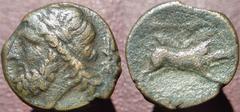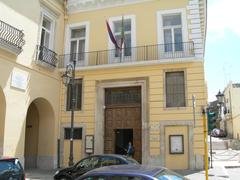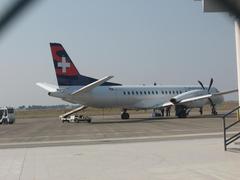
Unmasking Foggia: The Rebel Heart of Italy’s Sun-Kissed South
Date: 04/07/2025
Welcome to Foggia, Where Sunflowers Gossip and Every Espresso Tells a Tale
Step off the train in Foggia and the first thing that greets you is more than just the sun—it’s an intoxicating blend of baking bread, strong espresso, and the echo of centuries-old stories swirling in the southern air. This is a city built atop ancient grain pits, where wheat reigns supreme and legends simmer beneath every cobblestone. Forget the glossy postcards and crowded piazzas—Foggia is Italy’s forgotten pantry, a treasure trove of folklore, rebellion, and culinary genius, where even the shadows share secrets of Madonna miracles and nonnas who could out-cook the gods.
Each street is a breadcrumb leading to a myth: perhaps the trio of mysterious flames that drew villagers to a lost Madonna icon, or the golden Tavoliere plains that once fed emperors and inspired poets. Discover echoes of the past at the proud, timeworn Palazzo Dogana, or chase street art sheep in sunglasses down Vicolo delle Ombre.
Yet, Foggia is no museum piece. It’s a feast for the senses: bustling markets overflowing with bursting tomatoes and olives gleaming like black pearls, festivals alive with incense and blue Madonna banners, and the riotous flavors of the Fiera di Foggia. If fortune smiles, a local might teach you to say “Ué!” or invite you to a rooftop sunset; if you’re adventurous, you’ll brave a plate of lampascioni at a festival—slimy, spicy, and unforgettable (TasteAtlas).
Think of this guide as a layered loaf—a journey through Foggia’s history, flavors, and hidden delights. As the locals say: “Siamo come il pane—semplici fuori, ricchi dentro.” (We’re like bread—simple outside, rich inside.)
For a deeper dive into Foggia’s soul, browse Understanding Italy’s Foggia province page or explore culinary treasures with Oro del Salento’s Apulian cuisine guide.
Your Map to Mischief: Foggia’s Themed Adventure Index
Foggia: Where Legends Smolder and Wheat Fields Whisper
The Breadbasket’s Secret Recipe: Myths, Marvels, and Madonna Miracles
Foggia’s roots are literally set in bread—grain storage pits called “fovea,” possibly the city’s namesake. Or perhaps it’s named for “fire,” inspired by the legendary flames that revealed a lost Madonna icon in the 11th century. Visit the cathedral and seek the Madonna’s secret corner—blessing and Instagram likes await.
Beneath the myths lie even older stories: Neolithic farmers from Passo di Corvo, just outside the city, once sowed these fields. The ancient city of Arpi, now buried by the Tavoliere, once rivaled Rome itself. Foggia’s past is layered, profound, and ever-present.
From Norman Knights to Rebel Rallies: A City That Rises (and Rises Again)
Foggia’s resilience is legendary. Following the Madonna miracle, Norman knights and Emperor Frederick II made Foggia a hub, constructing palaces and welcoming pilgrims. Frederick’s palace remains only as a doorway, “la porta che resiste”—the door that endures. The city endured wartime bombings and revolutionary plots, its scars worn with the pride of survivors.
Taste the Tavoliere: A Market of Senses
Foggia’s markets are a sensory carnival—tomatoes threatening to burst, artichokes stacked high, and olives glistening. Farmers shout, espresso cups clink, and festival banners flutter. Sample grano arso pasta—a relic of thrift and culinary brilliance—paired with robust Nero di Troia wine, and you’ll understand why Foggia is Italy’s “granary.”
Insider Tip: Skip the main square for a panzerotto on Via Arpi, or join the morning crowd at Mercato Rosati for an “un caffè stretto” and fresh gossip.
Hidden Layers: Foggia’s Best-Kept Secrets
- The Whispering Well of Piazza Federico II: Drop a coin, whisper a wish, and legend says it travels to the Madonna herself.
- Vicolo delle Ombre: An alley painted with murals honoring Foggia’s rebels and dreamers—can you spot the sheep in sunglasses?
- Palazzo Dogana’s Rooftop: Occasionally open during festivals, offering magical sunset views.
Festival Frenzy: Mini-Quest
In spring, join the Festa della Madonna dei Sette Veli—a swirl of processions, music, and veiled icons. In summer, the Fiera di Foggia brings a sensory overload of food and celebration. Can you taste three cheeses and pronounce “caciocavallo” without laughing?
Local Lingo: Talk Like a Foggiano
- Ué! – The universal greeting.
- Sté bbón! – “Stay well!”
- Sciambagn! – “Let’s go!” or “Hurry up!”
- Mo’! – “Now!” (Best for snagging the last pastry.)
- Phrase to try: “Ué, sciambagn mo’—c’è la Madonna che aspetta!” (“Hey, let’s go now—the Madonna’s waiting!”)
Social Secrets: How to Foggia Like a Local
- Greet with two cheek kisses—even new acquaintances.
- Wait for “Buon appetito!” before eating.
- Wear blue during Madonna festivals and expect invitations to dance.
Myth-Busting: More Than Wheat and Heat
Foggia is not just a farm town—it’s been a royal court, a revolutionary center, and even appeared in Italian cinema (“Pane e Tulipani”). Locals are proud: “Siamo come il pane—semplici fuori, ricchi dentro.”
Itineraries for Every Appetite
- History Buff: Museo Civico, Cathedral, and Piazza Nigri’s grain pits.
- Foodie: Mercato Rosati espresso, lunch at Trattoria Pugliese, sunset at Palazzo Dogana.
- Rebel’s Ramble: Street art on Vicolo delle Ombre, Nero di Troia at an enoteca, gelato at Piazza Umberto Giordano.
Foggia in the Seasons
- Spring: Fields bloom, Madonna festivals abound.
- Summer: Wheat harvest, open-air concerts, Fiera di Foggia.
- Autumn: Truffle markets and wine tastings.
- Winter: Roasting chestnuts, Christmas lights, and cozy soups.
Pop Culture Cameos
Find Foggia in Italian music (Gianna Nannini’s “Fotoromanza”) and films (“Pane e Tulipani”).
FAQ: Foggia Unfiltered
- Is Foggia safe? Yes, but stay alert in crowded places.
- How to get there? Trains from Bari, Naples, and Rome—station is central.
- Must-try food? Grano arso pasta, local tomatoes, and bread.
- Is English spoken? Some, but Foggian phrases and a smile go far.
- Hidden gem? Underground grain pits at Piazza Nigri—ask a local guide.
Pro Tips—With a Twist
- Siesta: Shops close 1–4pm; use this time for gelato and planning.
- Transport: Walking is best; comfy shoes recommended.
- Festivals: If crowds gather, stick to the edges and keep moving.
Foggia: Italy’s Unsung Treasure Hunt
Arriving in Foggia, the southern sun winks at you, and the air is thick with espresso, wildflowers, and a hint of intrigue. Every alley is a breadcrumb; every piazza, a new story. Ready to play detective? Let’s explore Foggia’s best-kept secrets.
The Foggian Treasure Map: Your Adventure Options
- Eat like a Nonna: See Foodie Detective itinerary.
- Chase legends after dark: See Night Owl’s Guide.
- Collect local slang: Try it out with flair.
Act I: Historic & Architectural Landmarks
Cathedral of Foggia: Romanesque meets Gothic; home to the Madonna dei Sette Veli legend. Count the angels on the façade for fun.
Palazzo Dogana: Once a customs house for sheep, now a UNESCO site and occasional gallery. Ask about the Transumanza parade.
Teatro Giordano: Neoclassical theatre celebrating composer Umberto Giordano.
Piazza Umberto Giordano: Bronze opera statues, lively cafés—spot all seven for bonus points.
Palazzo De Vita – De Luca: Renaissance palace; peer through the gates and imagine historic revelries.
Act II: Museums
Museo Civico di Foggia: Daunian relics, Roman mosaics, medieval curiosities.
Archaeological Museum of Foggia: Tools and treasures from the mysterious Tavoliere civilization.
Museum of Firefighters & the Red Cross: Vintage gear and heroic stories; try on a fireman’s helmet.
Act III: Spiritual Sites & Rituals
Santuario Madre di Dio Incoronata: Miracles and festivals every April; pilgrims tie ribbons to olive trees for luck.
Chiesa Rettoria dell’Addolorata: A quiet, cool retreat with magical ambiance.
Act IV: Green Escapes & Public Squares
Villa Comunale: Foggia’s “living room”—fountains, shady lanes, and gelato kiosks.
Parco Urbano Karol Wojtyla: Jogging, cycling, and wildflowers.
Piazza Cavour: Central fountain, lively shops, and the city’s daily drama.
Act V: Eat, Drink, and Be Foggian
Mercato di Piazza Mercato: Noisy, fragrant, and full of local character. Find a new cheese to try.
Mercato Rosati: Smaller, lively, and great for olive oil tastings.
Borgo Turrito Winery: Countryside wine tours—legend says Bacchus himself stayed.
Act VI: Beyond the City
Parco Nazionale del Gargano: Ancient forests, wild orchids, and medieval villages.
Parco Archeologico di Siponto: Roman ruins and a stunning wire-mesh basilica.
Castello di Lucera: Fortress with panoramic views and a Roman amphitheater.
San Giovanni Rotondo: Pilgrimage site of Saint Padre Pio.
Act VII: Foggia After Dark & Oddball Adventures
Auditorium Santa Chiara: 15th-century church reborn as a music venue.
Stadio Pino Zaccheria: Football matches are a passionate spectacle.
Tre Archi: Medieval gate and Instagram favorite.
Local Lingo
- Ué! – Universal greeting.
- Mo’ – “Now!”
- Forza Foggia! – “Go, Foggia!” (at football matches).
Foggia Through the Seasons
- Spring: Wildflowers and bustling markets.
- Summer: Nightlife moves outdoors.
- Autumn: Grape harvest and chestnut roasts.
- Winter: Carnival, cozy trattorias, and pork roasts.
Sample Itineraries
Foodie Detective: Espresso at Piazza Cavour, cheese hunt at the market, picnic in Villa Comunale, wine at Borgo Turrito, aperitivo at Piazza Umberto Giordano.
Night Owl: Stroll past Tre Archi, dinner at a trattoria, show at Teatro Giordano, late-night gelato.
Local Etiquette & Surprises
- Coffee is savored, not rushed.
- Buses are unpredictable; walking is best.
- Legendary stories abound—ask a local for their favorite football victory tale.
Feasting in Foggia: The Ultimate Foodie Guide
Foggia is Italy’s pantry—golden wheat fields, endless olive groves, and meals that celebrate life itself.
The Foggian Foodie Road Trip
Stop 1: Wheat Heartland The Tavoliere delle Puglie is famed for its wheat. Find a bakery using a wood-fired oven and order Pane di Monte Sant’Angelo.
Stop 2: Markets & Muschiska Dive into the central market for olive oil tastings and muschiska—the shepherd’s jerky. Hunt down a trattoria with a changing menu for true local flavor.
Stop 3: Cheese & Veggies Visit a caseificio for caciocavallo, pecorino, ricotta, and the delicate giuncata. Try lampascioni (wild onions)—a local delicacy.
Stop 4: Coastal Cuisine On the Gargano coast, savor grilled fish, cozze al forno, and eel from Lesina. The Adriatic’s bounty is unmatched.
Stop 5: Sweets & Festivals Cartellate, calzoncelli, and almond sweets fill the air with temptation during festivals.
Food Lingo
- Muschiska: Spicy, dried meat.
- Friselle: Crunchy bread rings.
- Lampascioni: Wild onions.
- Cacci e mmitte: Local wine.
Do’s and Don’ts
Do:
- Greet warmly and eat slowly.
- Ask for the daily special—there’s always a story.
Don’t:
- Order cappuccino after noon.
- Rush your meal.
Culinary Myths Debunked
Foggia isn’t just wheat and pasta—its cuisine is diverse, featuring seafood, wild greens, and fine wines like Nero di Troia.
A Day in Foggia: Foodie Adventure
- Morning: Market tasting.
- Lunch: Orecchiette in Lucera.
- Afternoon: Coastal fish feast.
- Evening: Festival fare and folk dancing.
- Nightcap: Local wine under the stars.
Sensory Seasons
- Spring: Wild greens and fresh grass scents.
- Summer: Tomato and lampascioni abundance.
- Autumn: Grape harvest and olive pressing.
- Winter: Stews and Christmas pastries.
Foggian Food FAQ
- Must-try: Orecchiette, muschiska, lampascioni.
- Vegetarian-friendly: Yes—plenty of legumes and greens.
- Dining hours: Lunch 12:30–14:30, dinner 19:30–22:00.
- Wine: Ask for “Cacc’e Mmitte di Lucera.”
Ready for Your Foggian Adventure? Download Audiala!
For local tips, hidden trattorias, and unforgettable flavors, the Audiala app is your must-have companion (TasteAtlas, Oro del Salento, Understanding Italy).
Foggia Cheat Sheet: Curiosities, Quotes, and Pop Culture Nuggets
- TasteAtlas: Best-rated dishes in the Province of Foggia
- Oro del Salento: Typical Apulian cuisine—what to eat in Puglia
- Understanding Italy: Foggia province page
Ready to unlock Foggia’s secrets? Let Audiala be your witty local guide and audio sidekick. Peel back the city’s layers—from grano arso bread to Madonna miracles, opera haunts to wildflower fields—and discover a living, breathing storybook. Follow your nose, your appetite, and your curiosity into a world where every alleyway and every festival is a new adventure. Foggia awaits—make your mark in Italy’s breadbasket!
Audiala2024





